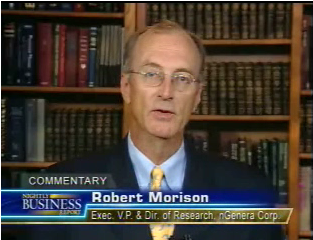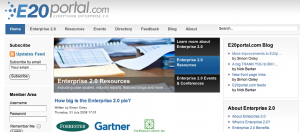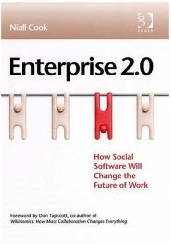 A number of us at nGenera have been discussing internally what it means to communicate and create a supportive, yet fluid culture in the 2.0 era. One of our guys asked the question, “what was your ‘a-ha’ moment when Web 2.0 suddenly made sense and you became a true believer?” I’ve had a number of “a-ha” moments, but my very first was probably when I disagreed with Andrew McAfee (the widely acclaimed father of Enterprise 2.0) and published my POV on my blog. The piece got picked up in an influential blog that gave credence to my argument. I didn’t know Andrew (Andy) at the time, and was slightly terrified to take on a Harvard professor in the blogosphere. But in that single interlude, I realized that my tiny voice could make a difference. I could contribute to a greater discussion without the typical stereotypical handicaps (gender, class, education, privilege) that would otherwise squelch my opportunity to be heard. In other words, the “egalitarian, unstructured, emergent” platform of the next generation web was really that– a deeply satisfying democratic clearinghouse for idea-sharing and progress.
A number of us at nGenera have been discussing internally what it means to communicate and create a supportive, yet fluid culture in the 2.0 era. One of our guys asked the question, “what was your ‘a-ha’ moment when Web 2.0 suddenly made sense and you became a true believer?” I’ve had a number of “a-ha” moments, but my very first was probably when I disagreed with Andrew McAfee (the widely acclaimed father of Enterprise 2.0) and published my POV on my blog. The piece got picked up in an influential blog that gave credence to my argument. I didn’t know Andrew (Andy) at the time, and was slightly terrified to take on a Harvard professor in the blogosphere. But in that single interlude, I realized that my tiny voice could make a difference. I could contribute to a greater discussion without the typical stereotypical handicaps (gender, class, education, privilege) that would otherwise squelch my opportunity to be heard. In other words, the “egalitarian, unstructured, emergent” platform of the next generation web was really that– a deeply satisfying democratic clearinghouse for idea-sharing and progress.
Since that time, I’ve come to know and really like Andy. I was always curious about how his own background might have had some bearing on his ideology regarding enterprise 2.0. I took the opportunity to have a one-on-one with Andy at the Enterprise 2.0 conference to get a more complete picture of his history and path to fame. It didn’t surprise me to learn that Andy grew up in a small town in the mid-west. His parents divorced when he was a boy, and his Mom worked hard as a single mother to give him and his siblings an excellent education. He characterized himself as “socially awkward” and a bit of a math and English geek. Through the pages of the New Yorker magazine, which he read cover to cover, he found a “periscope into something else” that he wanted to belong to. A top student, Andy left high school in his Junior year to become an undergraduate at MIT where he was accepted early. At MIT, he felt he was, “finally among my people.” He described his fellow students as “bizarrely talented in different ways.” He joined a fraternity, pulled off a double major in Mechanical Engineering and French (Humanities) and eventually left MIT with two M.S. degrees in Mechanical Engineering and Management. He describes one of the highlights of his life being the day he received his admittance letter to MIT.
As far as foreseeing his web-celeb fame, he could not be more surprised. In fact, he says he had, “No master plan” and “fell into business studies by accident.” Although he worked as a consultant in operations management after graduation for a few years, he found the business professional life, well, boring. He made a decision to return to school to get his doctorate, at Harvard this time. He wrote his dissertation on (gulp) modern ERP and the performance of on-time shipments before and after an R/3 installation.
During our breakfast, I had posited that because of his unprivileged background, he might have a bent toward “subverting the prevailing paradigm.” He said he wasn’t sure. But he said through his own experience, he learned “expertise can be emergent” and that few if any of his peers in college came from privileged backgrounds, but all were vastly talented. He cited the example of his mom who started as a bookkeeper in downtown Chicago and worked toward an accounting degree at night. Today, she’s the CFO of that company.
 I think I’m going to disagree (with love) once again with Andy. When you see him tooling around Cambridge on his motorcycle in his leather jacket, you wonder if he’s not just a little rebellious. After all, he’s the iconic champion of turning business and technology on its head– removing the walls that separate individuals and encouraging management to consider there is an alternative to hierarchical command and control. They say there is a perfect job out there for everyone. Andy McAfee has earned the right to lead the culture clash that comes with e2.0. I can’t think of a better candidate.
I think I’m going to disagree (with love) once again with Andy. When you see him tooling around Cambridge on his motorcycle in his leather jacket, you wonder if he’s not just a little rebellious. After all, he’s the iconic champion of turning business and technology on its head– removing the walls that separate individuals and encouraging management to consider there is an alternative to hierarchical command and control. They say there is a perfect job out there for everyone. Andy McAfee has earned the right to lead the culture clash that comes with e2.0. I can’t think of a better candidate.







 A number of us at
A number of us at  I think I’m going to disagree (with love) once again with Andy. When you see him tooling around Cambridge on his motorcycle in his leather jacket, you wonder if he’s not just a little rebellious. After all, he’s the iconic champion of turning business and technology on its head– removing the walls that separate individuals and encouraging management to consider there is an alternative to hierarchical command and control. They say there is a perfect job out there for everyone. Andy McAfee has earned the right to lead the culture clash that comes with e2.0. I can’t think of a better candidate.
I think I’m going to disagree (with love) once again with Andy. When you see him tooling around Cambridge on his motorcycle in his leather jacket, you wonder if he’s not just a little rebellious. After all, he’s the iconic champion of turning business and technology on its head– removing the walls that separate individuals and encouraging management to consider there is an alternative to hierarchical command and control. They say there is a perfect job out there for everyone. Andy McAfee has earned the right to lead the culture clash that comes with e2.0. I can’t think of a better candidate. So, yeah. I wanted to change the world in my 20s. In some ways, I thought I could with Unix and my
So, yeah. I wanted to change the world in my 20s. In some ways, I thought I could with Unix and my